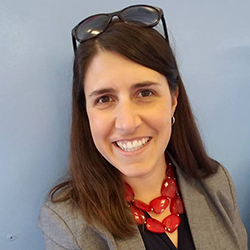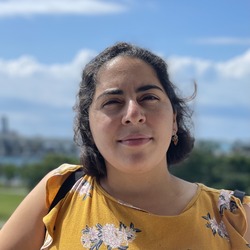STEP UP: Supporting Teachers to Encourage the Pursuit of Undergraduate Physics
By Bree Barnett Dreyfuss, Pooneh Sabouri, Nicole Schrode
While school districts continue to shift to the California Next Generation Science Standards (CA NGSS) teachers and administrators alike are taking a critical look at who does science in their schools. As seen in Figure 1, chemistry and biology have approximately equal percentages of female enrollment in high school. Physics tends to have slightly higher percentages of male students in high school but this number dramatically shifts when students continue to higher education.
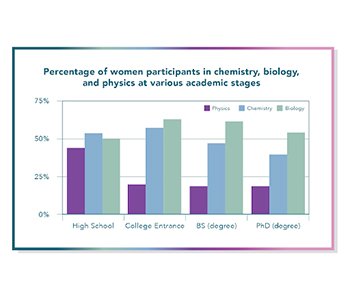
Figure 1: Percentage of women participants in chemistry, biology and physics at various academic stages. The data is compiled from three sources: the American Institute of Physics Statistical Research Center, the Higher Education Research Institute & Cooperative Institutional Research Program at UCLA and the Integrated Postsecondary Education Data System of the National Center for Educational Statistics.
While nearly half of all high school physics students are female, there is a stark decrease in the percentage that decide to continue studying physics in their undergraduate program. Research by Dr. Zarah Hazari and colleagues have found that a student’s sense of “physics identity,” if they feel like they are a “physics person,” is a strong predictor of students’ decision to pursue a physics major [1]. Moreover, how students identify as a physics person is heavily influenced by cultural narratives around physicists (e.g., who they are and what they do) [2] and these narratives often marginalize women and people of color [3]. However high school physics teachers have a crucial role in influencing and changing students’ views [4]. Building on this research and funded by National Science Foundation (NSF), a team of researchers and educators at the American Physical Society (APS), the American Association of Physics Teachers (AAPT), Florida International University, and Texas A&M at Commerce co-developed STEP UP curriculum and established their effectiveness by studying their impact within a diverse set of classrooms across the country. To disseminate the curriculum, support teachers, and create culture change the STEP UP community was formed. Together, this national group of physics teachers, researchers, and professional societies, including more than 1800 highschool physics teachers, aims to transform physics culture and inspire young women to pursue physics in college.
The STEP UP curriculum is freely available on the website, and consists of two classroom lessons and teacher support materials:
- The Careers in Physics lesson gives students the opportunity to match their career goals and field of interest with profiles of individuals with a physics degree. Students create their own future career profile that includes how a physics degree can help them accomplish their goals.
- The Women in Physics lesson helps students to reflect and think critically about who has historically studied physics. Students are presented with data to neutralize the effect of bias for marginalized groups and share personal experiences.
- The Everyday Actions Guide is a guided reflection for teachers. Focusing on reducing marginalization of their students while making their classrooms more inclusive throughout the year.
Each lesson includes a teacher guide, associate presentations, and student materials [6]. The online community provides additional support for implementation variations. During the global pandemic STEP UP teachers around the country shared their online versions of the lessons, their adaptations for different grade levels and the digital student profiles and projects their students created. Some teachers opt to expand the Women in Physics lessons to include data on other marginalized groups, local STEM resources like national labs and current events like Nobel Prize winners and their demographics.
These lessons address NGSS Science and Engineering Practices F (Engagement in arguing from evidence) and H (Science is a human endeavor). To help with classroom discussions throughout the year we have developed a classroom poster with our “Guidelines for Conduct during Discussions.” This poster has been used in hundreds of classrooms across the country to help learn how to have productive and inclusive conversations about science.
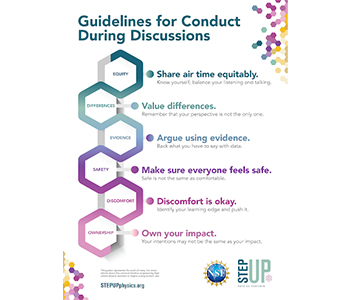
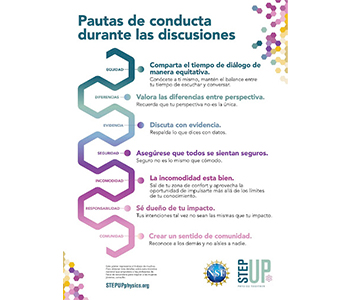
Figure 2: Guidelines for Conduct During Discussion poster, available in English and Spanish: https://engage.aps.org/stepup/curriculum/women
The STEP UP community continues to grow and expand as more teachers of physics join the movement. Together we are making our physics classrooms more welcoming and inclusive and showing all of our students envision themselves in a physics career.
Bree Barnett Dreyfuss, CASE member, physics teacher at Amador Valley High School and STEP UP Ambassador Program Coordinator, BreeBarnettDreyfuss@gmail.com
Pooneh Sabouri, STEP UP Project Manager, psabouri@fiu.edu
Nicole Schrode, APS Public Engagement Program Manager, schrode@aps.org
References
[1] Hazari, Z., Sonnert, G., Sadler, P.M. and Shanahan, M.-C. (2010), Connecting high school physics experiences, outcome expectations, physics identity, and physics career choice: A gender study. Journal of Research in Science Teaching, 47(8), 978-1003. https://doi.org/10.1002/tea.20363
[2] Lock, R. M., & Hazari, Z. (2016). Discussing underrepresentation as a means to facilitating female students’ physics identity development. Physical Review Physics Education Research, 12(2), https://link.aps.org/doi/10.1103/PhysRevPhysEducRes.12.020101
[3] M. Bruun, S. Willoughby, and J.L. Smith, “Identifying the stereotypical who, what, and why of physics and biology,” Physical Review Physics Education Research. 14(2), p. 020125 (2018), https://link.aps.org/doi/10.1103/PhysRevPhysEducRes.14.020125
[4] Hazari, Z., Brewe, E., Goertzen, R. M., & Hodapp, T. (2017). The importance of high school physics teachers for female students’ physics identity and persistence. The Physics Teacher, 55(2), 96-99. https://doi.org/10.1119/1.4974122
[5] Hemeng Cheng, Geoff Potvin, Raina Khatri, Laird H. Kramer, Robynne M. Lock, and Zahra Hazari. (2018) Examining physics identity development through two high school interventions. Physics Education Research Conference Proceedings; http://dx.doi.org/10.1119/perc.2018.pr.Cheng
[6] Sabouri, P., Hazari, Z., Barnett Dreyfuss, B., & Khatri, R. (in press) Considerations for Inclusive and Equitable Design: The Case of STEP UP Counternarratives in High School Physics. The Physics Teacher.
Related NGSS practices:
NGSS Appendix F – Science and Engineering Practices in the NGSS
Engaging in Argument from Evidence
- Compare and evaluate competing arguments or design solutions in light of currently accepted explanations, new evidence, limitations (e.g., trade-offs), constraints, and ethical issues.
- Evaluate the claims, evidence, and/or reasoning behind currently accepted explanations or solutions to determine the merits of arguments.
- Respectfully provide and/or receive critiques on scientific arguments by probing reasoning and evidence, challenging ideas and conclusions, responding thoughtfully to diverse perspectives, and determining additional information required to resolve contradictions.
- Construct, use, and/or present an oral and written argument or counter-argument based on data and evidence.
NGSS Appendix H – Understandings about the Nature of Science
Science is a Human Endeavor
- Scientific knowledge is a result of human endeavor, imagination, and creativity.
- Individuals and teams from many nations and cultures have contributed to science and to advances in engineering.
- Scientists’ backgrounds, theoretical commitments, and fields of endeavor influence the nature of their findings.
- Science and engineering are influenced by society and society is influenced by science and engineering.
